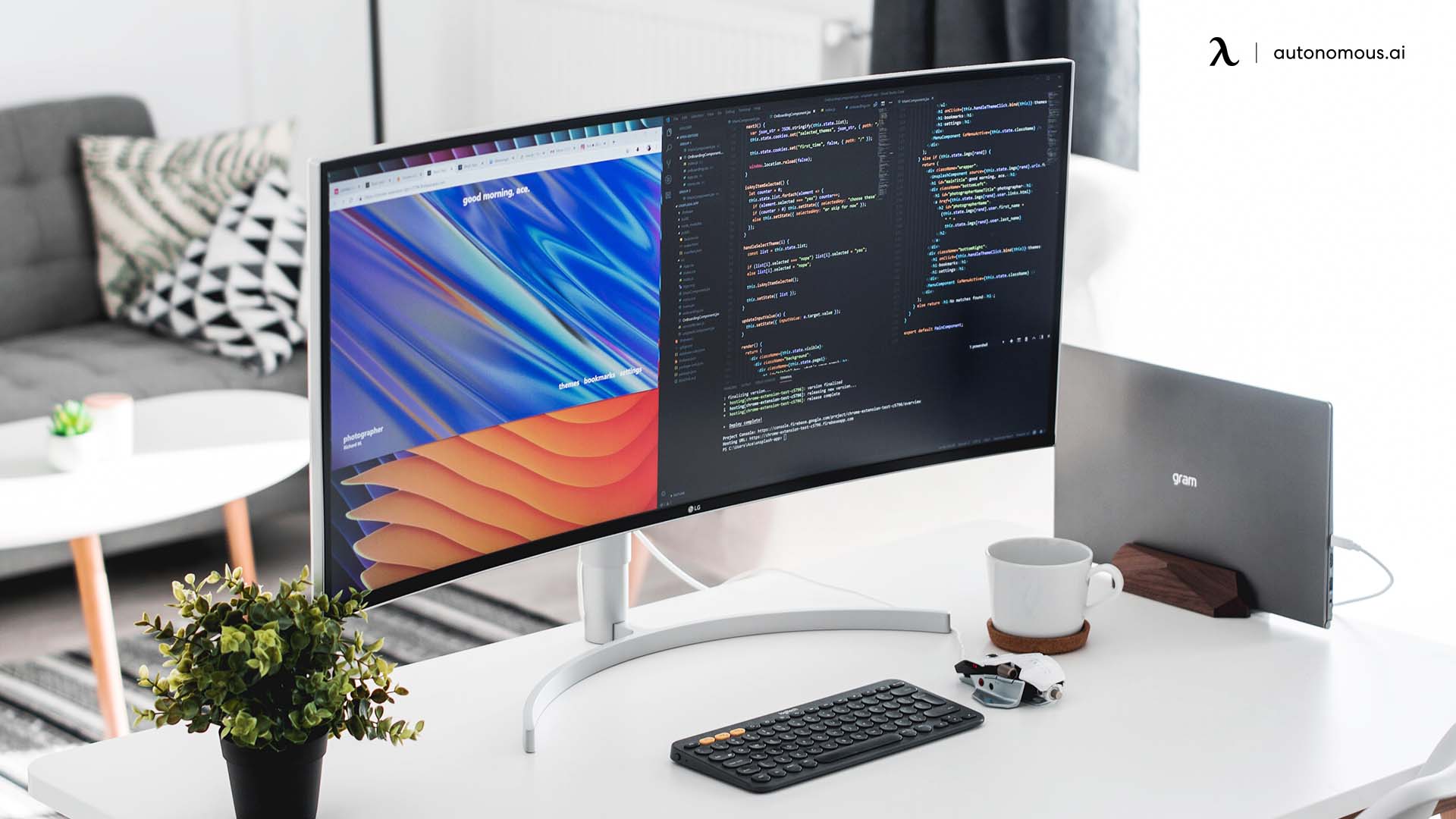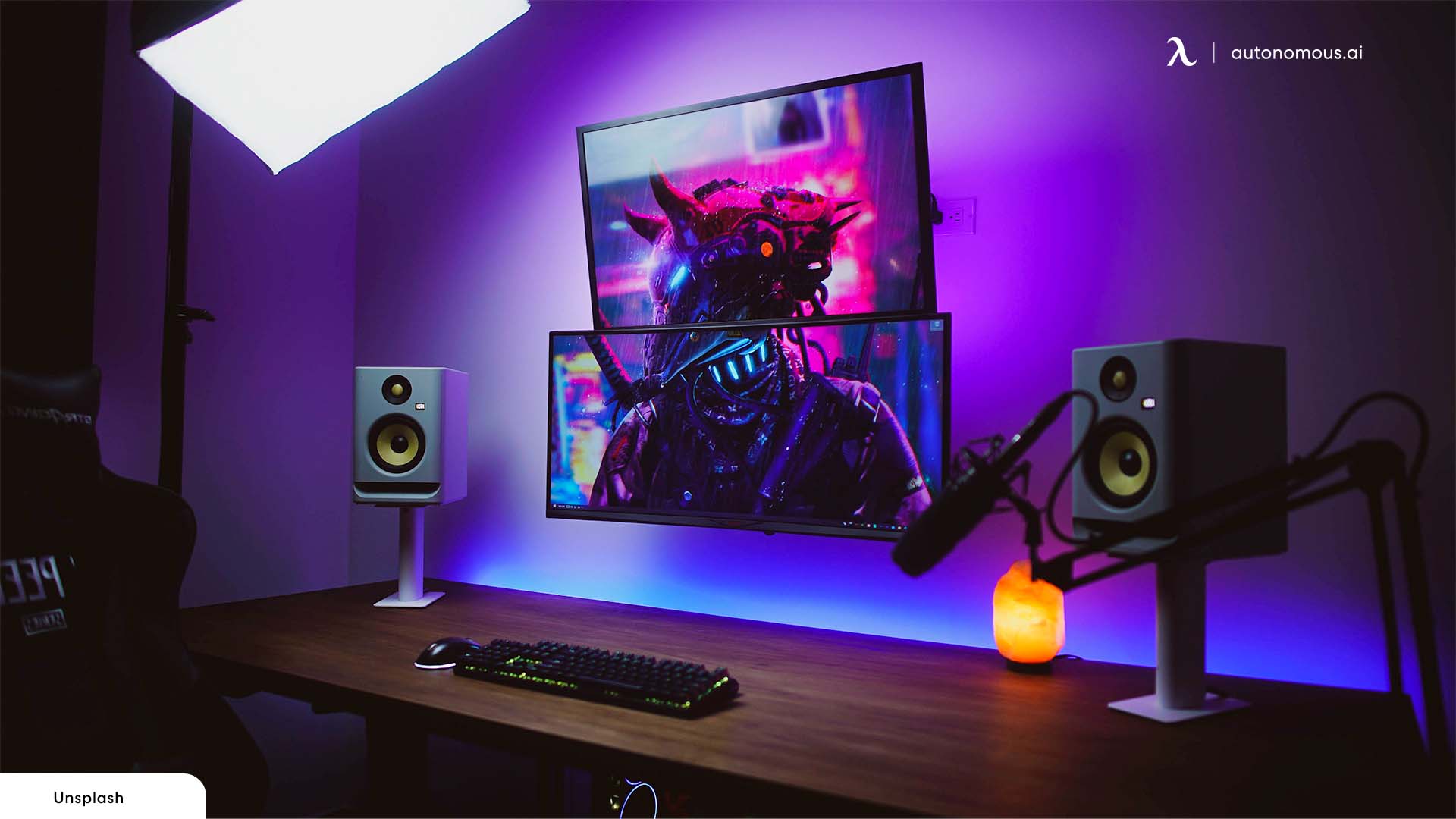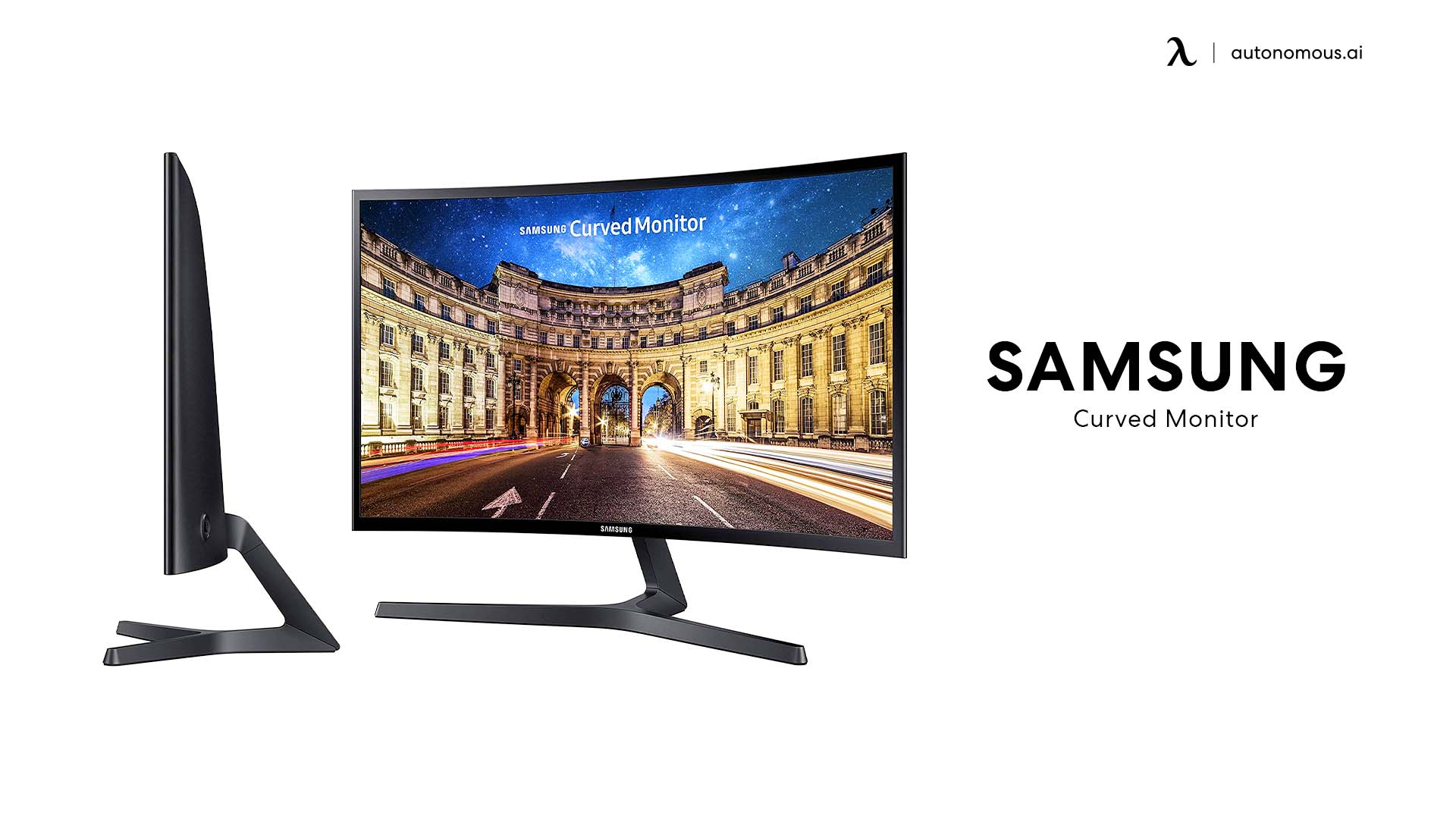Are Curved Computer Monitors Worth it? Pros and Cons
Whether setting up your home office or work space, you will need to consider the pros and cons of a number of new technologies. Some innovations, like a standing desk or an ergonomic chair, provide real health and productivity benefits. Other office trends, like cheesy motivational posters, we may be better off without.
One of your first decisions when customizing your work space will be selecting a computer monitor, if you do not work from a laptop. Curved monitor screens have become a huge tech trend since they were first introduced in 2014, replacing the once-cutting edge flat screen monitors. In 2018, Samsung alone sold seven million curved computer monitors, and Statista estimates that global shipments of curved monitors was approximately 10.4 million in 2019 and will be around 12.9 million in 2020.
Despite the spike in sales, curved screens are undoubtedly more expensive than their flat counterparts, costing 40%-65% more for relatively equal specs. So, are these curved screens worth the investment, or are they just a gimmick?
There are a number of benefits of curved monitors, but they may not apply to every person. There’s no wrong answer, but doing your homework will help you make the right decision for your needs. Between curved vs. flat monitor, which one is better? Are curved monitors worth it? Are curved monitors good for work? Here are some curved monitor pros and cons. Let's find out!
Pro: Curved Monitors Are More Immersive
In all likelihood, the biggest reason you may even be interested in these large curved monitors is they deliver a more immersive experience than flat screens. The screens fill up more of your peripheral vision, allowing you to focus more on your work, movie, or game rather than the distractions of the real world around you.
The curved screen technology utilizes concepts of “ocular perception” to create this immersive experience, blending more seamlessly into your peripheral vision. Particularly for gaming, entertainment, or creative work, this can be a seductive experience.
Con: Curved Monitors May Have More Glare, Causing Eye Strain
A downside to curved monitors is that the larger, arched display can catch light from more angles. This makes glare a bigger issue for curved screens than flat screens, since glare can block or obscure sections of the screen. Not to mention, glare is a cause of eye strain, potentially causing headaches or blurred vision.
Of course, flat screen monitors can still cause glare if positioned at the wrong angle, but they are easier to move and set up in an area with less light. For either type of monitor, place the screen away from as many light sources as possible and use low, ambient light around your computer to reduce glare.
Pro: Curved Monitors Have Less Distortion
Everyone has had that annoying experience when you try to enlarge a picture, PDF, or video, and the quality ends up grainy and distorted, especially around the edges. Curved monitors have a slight advantage in reducing distortion, especially for wide/large images.
Put simply, the difference between curved and flat screen distortion comes down to the physics of light projection. With flat monitors, the image is projected at you in a straight line, such that for a large image some elements will project past your head. With a curved monitor, the entire image is directed at your eyes, ultimately leading to a less distorted picture even as you zoom in.
Con: You May Lose Most of Your Wall Space to a Curved Monitor
Curved monitors typically have a 21:9 aspect ratio, compared to a traditional 16:9 aspect ratio for flat screens, which means curved screens are significantly wider than they are tall. While there are obvious benefits to seeing more information spread out across more horizontal space, this also means the screen may end up taking up the entire length of your desk.
It is worth mentioning that the curve of the screen results in a bigger depth of the screen; that is, the screen will take up more space in front of your wall. Most curved monitors are about 40 millimeters greater than flat screens, and can make your office space feel slightly more cramped.
Speaking of wall space, another consideration is that due to their signature shape, curved screens are more difficult to mount on a wall or desk stand. While flat screens can rest flush against the wall, curved screens require specific positioning and mounts to rest against the wall. Brackets and adjustable mounts—such as the Autonomous Arm Mount—may be useful options to tilt, swivel, and adjust the screen as needed.
Pro: Curved Monitors May Be More Comfortable
Although curved screens are more popular for immersive and aesthetic reasons, manufacturers also like to boast about how their screens can reduce eye strain. Naturally, the shape of a curved monitor more closely resembles the curvature of the eyeball, giving your content a more natural feel.
Essentially, the curvature of the screen allows the eye to view everything on screen without strain. This can result in a more organic and comfortable viewing experience.
Con: Slower Performance for Gaming and Streaming
Since curved screens are a relatively newer technology, they have not yet caught up to flat screens in terms of high-speed performance. In general, gaming reviewers have found that flat monitors tend to have faster refresh rates, response times, and color accuracy.
Flat monitors tend to be more widely available for high-speed performance at a reasonable price, while curved screens with similar high-speed specifications will come with a massive price tag. For avid gamers and video editors, a flat screen monitor will offer the highest level of refresh rate with a low input lag and response time.
Pro: Curved Panels Tend to be Lighter
An unexpected benefit of curved panels is the difference in weight. As a newer technology, curved screens tend to be around 3 kilograms lighter than flat monitors.
While you may not notice the weight difference in your day-to-day usage, this can be a substantial difference depending on the accessories you want to use. If you plan to tilt and swivel your screen—such as with a VESA-compatible mount—or use a glass-top desk, the lighter screens might save you a headache.
Con: Curved Panels May Cause Neck Strain
The benefits of an ergonomic office setup are well-documented, and can result in higher productivity, better health, and more focus. Although the curvature of a curved screen results in a more comfortable viewing experience, it is also possible that the wider horizonal space will result in shifting your head back and forth more often.
Turning your neck more frequently to focus on different parts of the screen can result in neck strain, leading to headaches and soreness. This can be overcome by sitting further away from a curved monitor, but that is not always possible with a small desk or office space. Since flat panels are easier to set up on a flexible monitor arm, they may also provide more ergonomic viewing options while working, although this is also possible with a curved screen depending on your specific work setup.
Pro: Multitasking Made Easy
For those who currently use two connected screens for work or gaming, the wider curved screens may be your answer. If you tend to work across multiple documents, tabs, or programs, increasing the real estate of your physical screen space can be a lifesaver.
Due to the 21:9 aspect ratio of most curved screens, they tend to be widescreen and are even available in ultrawide monitors, making workflows and multi-tasking much easier. The alternative would be a dual-monitor setup or a large flat widescreen, but both do not fall short of the smooth experience of an ultrawide curved monitor.
Con: Limited Variety of Accessories Available
Since the curved screens are relatively new and are not as widely dominant in the market as flat screens, office accessories can be less varied or more expensive. Certainly, many curved monitors come with high-quality stands and mounts.
However, curved monitor accessories simply don’t have the range of price, weight, customization, design, and color options for arms offering tilt, swivel, height, and rotational adjustments.
Curved vs. Flat Monitor
Flat monitors have reigned in the industry for several years, but curved screens have become quite prominent in the modern era, especially in the gaming scene. However, certain differences between both options may make it appropriate for different users.
Are curved monitors worth it? This section will help you identify the best monitor for your needs. Curved monitors have several benefits, including a noticeably curved screen and sleek appearance. However, there are certain things regarding their performance that you may want to take into account. Flat screens have been present in the market for several years, and they continue to be the industry standard at the moment.
Here we'll present you with the main differences between gaming and regular monitors.
Immersive experience
Curved monitors provide the user with a more immersive experience. This is possible thanks to the curved design, which takes advantage of the human ocular perception so you can perceive the three dimensions while you’re using the monitor.
Lack of distortion
Another benefit of a curved monitor includes the inexistence of distortions. Your screen will show a clear image the majority of the time. On the other hand, a flat-monitor is usually vulnerable to these issues unless you're willing to spend a few extra bucks on a premium option.
Curved screens are better for your sight
A curved monitor might be more comfortable for your eyes than a regular flat option. Again, these screens take advantage of your eye's natural movements. Hence, it'll be easier for you to focus on what's on the screen while also reducing the risk of eye fatigue.
Improved field of view
You will access a wider field of view. You will be able to observe more things on your screen, especially when it comes to FPS games or even charts if you’re into trading.
Mounts
It can be complicated to mount your curved monitor on a wall due to its shape. In fact, curved monitors require very specific mounts and determined positions for them to be placed correctly on the screen. This has no impact on the performance of the device whatsoever. On the other hand, flat screens are quite easy to mount and are compatible with most mount types available in the market.
Glaring
Curved monitors may present glaring issues from time to time. This doesn’t happen all the time and is more likely to be present at specific angles. You can solve this by preventing light sources from reaching your monitor from a determined angle.
Best 5 Curved Monitors
1. Samsung 32-inch Curved LED Monitor
This ultra-slim curved monitor is perfect for the office and for gaming. It has a refresh rate of 60 inches, making it a good option for those looking forward to transitioning from flat monitors to curved displays. Plus, it comes with an energy-saving mode that will automatically help you maintain the screen brightness at the optimal level to save power.
2. Gaming Screen PXC325 by Pixio
The Gaming Screen PXC325 by Pixio is one of the best screens available in the market. It provides you with an ample screen of 31.5 inches and HDR and G-Synch Compatibility. Plus, it has AMD FreeSync Premium technology integrated, ensuring you have the utmost experience whether you’re watching a movie, editing video or images, or perhaps playing your favorite games.
The monitor is equipped with a 165HZ refresh rate, 1ms of response time, and eye-saver mode. It solves one of the biggest problems of curved monitors by integrating an easy-to-use VESA mount. Pixio monitors always have high-quality more than assured.
3. AOC C24G1 Curved Monitor
This curved monitor is an excellent choice if you’re looking for a budget option. It is a smaller screen (it has a width of 24 inches), but it can be a good choice for people with reduced spaces. You will get enough clarity and quality for you to perform diverse activities. This small monitor can be a good option for a laptop and monitor setup.
4. Gaming Screen PXC327 by Pixio
This is another option by Pixio. The Gaming Screen PXC227 is slightly bigger than the option previously mentioned, with a width of 32 inches. This display is also compatible with HDR, G-Sync, and AMD FreeSync Premium. Thanks to the WQHD resolution (2560x1440p), you will be able to have the utmost experience while consuming any piece of media.
This gaming screen is an excellent option if you’d like a wider display that provides you with a higher image resolution. It is one of the best monitors for work and gaming.
5. Dell Curved Monitor S2721HGF
This option is another budget option you can choose. It has a refresh rate of 144Hz and has a total width of 27 inches. It has the standard HD resolution (1980x1080p). The curve isn’t too prominent but is noticeable, so you will have the desired effect once your monitor is on. It is a good starter curved monitor for those who are using one of these options for the first time.
FAQs
Are curved monitors good for work?
Yes, they are good for work. They can help you increase the ergonomics of your workstation as they will allow you to see the screen in a natural way.
Do professionals use curved monitors?
Many professionals have started using curved monitors due to the expanded field of view and ergonomic features they include. Right now is the best time for you to include a curved monitor in your desk setup.
Are curved monitors outdated?
Curved monitors are not outdated. Contrary to this, these displays are very advanced due to the modern technologies implemented on them.
Is a curved monitor better than a flat one?
Flat screens are still the industry standard, and they will continue to be on that spot for a long time. Still, curved monitors are an excellent alternative that can provide you with a better visual experience. Both options have their ups and downs.
Do curved monitors reduce eye strain?
Yes. Thanks to the curved design, your eyes will follow a natural field of view while you’re using them. Some of them also come with automatic brightness options, which means they can help you reduce eyestrain during your work sessions.
Final Thoughts
While there are many differences, both curved and flat monitors are available with high resolution, beautiful imaging, and compatibility with your other computer elements.
If you have a large enough room, customizable lighting conditions, and spend a lot of time editing horizontal video or playing games, it is likely worth the investment to add a curved computer monitor to your work space. If you have a small space, little control over the room’s lighting, and use your computer for general tasks like writing, web browsing, and normal streaming, a flat screen display may be more than enough.
Subscribe for a 10% discount on your first order.
Sign up for our weekly update and be the first to know about our specials & promotions.
















.jpg)


